
 | |
| Volume 6, Number 2 | March/April 2000 |
Several years ago The Biblical Chronologist launched a research project to obtain modern radiocarbon dates on the Cave of the Treasure reed mat. The first result from this modern redating has now been obtained. As is often the case in science, the result is a bit of a surprise.
Several years ago I discussed radiocarbon dates which had been obtained in the 1960s on the Cave of the Treasure reed mat (Figure 1).[1] This very ancient mat is of interest to Biblical chronology because of its possible relationship to Noah's Flood.
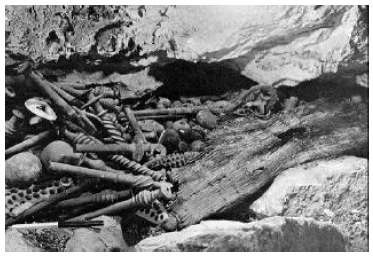 |
The idea in this case is as follows. The mat is constructed of reeds. If the reeds grew just prior to the Flood, then the mat can serve as a chronological proxy for the Flood—the date of the reeds (i.e., when they grew) will give us, very nearly, the date of the Flood. The date of the reeds can be determined using radiocarbon dating. Since radiocarbon dating is independent of Biblical chronology, we can use the radiocarbon date of the reeds to check the date of the Flood we have derived from Biblical chronology data.
The catch here is in knowing for sure whether the reeds of the mat grew just prior to the Flood. The possibility they did so suggests itself from several circumstances.
First, the advanced technological ability in metallurgy evidenced by the copper objects of the treasure found together with the mat argues for their origin late in the Chalcolithic period, and the Chalcolithic period in Palestine, we have many reasons to believe, came to an abrupt termination as a result of Noah's Flood.
Second, there is a considerable depth of Chalcolithic deposit in the Cave of the Treasure, indicating prolonged occupation. According to the excavators, "There is no doubt that the treasure was hidden towards the end of the occupation of the cave in the Chalcolithic period".[2] This seems to place the burial of the treasure, at least, later on in the Chalcolithic.
Finally, the coming of the Flood provides ready answers to several mysteries associated with the treasure. For example, the treasure appears to have originally been part of the furnishings of a Chalcolithic temple, the remains of which are located just six miles north of the Cave of the Treasure. The temple was found bare of furnishings by the archaeologists, and gives the impression of having been "abandoned". Meanwhile, the treasure was found by the archaeologists to have been buried, obviously in haste, and never reclaimed. If the treasure was buried just prior to the Flood—even perhaps because of the onset of the Flood—one has immediate answers to why the temple was "abandoned", why the treasure was buried hastily, and why it was never reclaimed.
But, admittedly, all such considerations fall short of proof. It is possible to imagine other calamities besides the Flood which might have given rise to these archaeological observations. Furthermore, the Chalcolithic period in Palestine was very long—in excess of a thousand years. So even though the treasure was buried after a considerable depth of Chalcolithic deposit had accumulated in the cave, it is still possible that further centuries of the Chalcolithic transpired before the coming of the Flood. And even if the treasure had been buried just prior to the Flood, one could still not guarantee that the reeds of the mat had grown just prior to the Flood. The mat might, for example, have had ritual significance, and have hung on the wall of the temple for hundreds of years prior to its burial in the Cave of the Treasure, for all we know. The dry climate of the region is certainly conducive to extended preservation, as the existence of the mat through more than five thousand years, down to the present time, clearly testifies. So the possibility that the reeds of the mat might have grown hundreds of years prior to the burial of the mat in the Cave of the Treasure cannot be excluded.
Obviously, the origin of the mat just prior to the Flood cannot be guaranteed up front. But the date of the mat is still of great interest to Biblical chronology as a potential means of checking the date of the Flood. I explained the logic behind this in the original article:[3]
We wish to use radiocarbon to date the Flood and thereby check our Biblical chronology work to the present time. If the mat originates at the close of the Chalcolithic (as the archaeological evidence seems to show) and if the Chalcolithic was terminated by the Flood (as the Biblical evidence seems to show) and if the proper date for the Flood is 3520±21 B.C. (as Biblical chronology seems to show) and if calibrated radiocarbon is a reliable dating method (as both theory and a great deal of practical experience seem to show) then the radiocarbon date of the mat should be in harmony with 3520±21 B.C. If, on the other hand, any of these things is not right, then there is no reason why the radiocarbon date of the mat should support the Biblical date.
The purpose of my original article was to point out that the radiocarbon dates which were available at that time on the mat did appear to support the Biblical date of the Flood. But I also pointed out that the radiocarbon dates on the mat needed to be checked. There were three reasons why this was so.
First, these radiocarbon dates were made over thirty-five years ago. Back at that time measurement techniques were crude compared to modern-day standards. It was immediately clear that a much more precise date could be obtained on the mat using modern radiocarbon dating technology.
Second, there was not complete harmony between the three radiocarbon dates available on the mat at that time. The three dates had been obtained by three separate labs. Two of the dates were in agreement, but the third was some 500 to 600 years older. (A fourth date, not on the mat itself, but rather on wood found in one of the copper standards, harmonized with the two mat dates which were in agreement. This gave three radiocarbon dates in agreement and one significantly different.)
Third, it seemed unlikely that the radiocarbon labs had corrected their radiocarbon measurements on the mat for isotope fractionation. This is a technicality with radiocarbon dating which can alter the calendar date of a sample by several hundred years. This correction requires that an additional measurement (of the 13C content of the sample) be made on the sample when its radiocarbon (i.e., 14C) assay is performed. While this additional measurement is routine in nearly all radiocarbon labs today, it was not carried out in many labs back at that time.
I began to inquire about the possibility of having a modern radiocarbon analysis performed on the mat before my original article had gone to press, in November 1997. To accomplish the goal of redating the mat using modern radiocarbon methodology I needed to locate the authorities responsible for the care of the mat today, and obtain their permission to have it redated.
It was clear from the beginning that the pertinent authorities were in Israel. But, connecting with the right people turned out to be more difficult than I had expected. My initial efforts came to nothing after several months. Unfortunately, I was swamped with other research related to the Flood at the time. It was clear that I would not be able to invest the time needed to track down the necessary permission. So I asked a friend and subscriber, Mr. Thomas (Tom) Godfrey, if he might be able to take up this particular quest on my behalf.
Though Tom had no professional background in either Biblical chronology or archaeology, he readily agreed to help, and went immediately to work on the problem.
I asked Tom to write up his experience. His account follows.
In a letter dated June 3, 1998, Dr. Aardsma invited me to "adopt" a research project related to the reed mat discussed in his article, "Radiocarbon Dating Noah's Flood" ( The Biblical Chronologist, Vol. 3, No. 6, pp. 1-11). He wanted me to locate that mat, which had wrapped copper objects in the Cave of the Treasure, and arrange to have it redated for the reasons explained on page 10 of the article. I accepted the assignment and soon received copies of his previous correspondence on the matter. He had written to someone on the staff of the Israel Antiquities Authority (IAA) on December 12, 1997, but no reply was ever received. He wanted me to follow up and develop other leads, if necessary, to see what more could be done.
Working exclusively through the Internet, by the end of June I had already learned that the reed mat was on display at the Israel Museum in Jerusalem and that it was the property of the IAA. I had even received the e-mail address of the curator at the museum who, over fifteen months later, would finally oversee the collection of the desired sample, but the next and most challenging task for me was to find out who could approve our request for a piece of the mat.
By the middle of July, I had received an e-mail from the curator, Osnat Misch-Brandl, who informed me that just the copper objects, not including the reed mat, had recently been studied again. She cited an article, apparently published in a Hebrew-language journal, and gave me the name of the main author (M. Tadmor). After several attempts to follow up, Harriet Menahem, the IAA secretary, promised to forward my inquiry to Ms. Katz, Chief Curator at the IAA. Little did I know at that time that it would be this curator who would eventually approve our request for a sample.
Not having any way to contact Ms. Katz directly, and since no further responses came in from either the museum or the IAA, even after waiting until December, I started searching on the web for any reference to an M. Tadmor on the theory that this researcher should be familiar with the proper channels for gaining access to the mat. After checking dozens of dead ends, I finally came across an article, "Some archaeological notes on Deuteronomy", by Jeffrey H. Tigay, who mentioned a Miriam Tadmor in his acknowledgments.
Noting that he was affiliated with the University of Philadelphia, I visited that university's website and found his e-mail address. By New Year's Day, he had replied to me with helpful information. Unfortunately, the approach through Mrs. Tadmor was to no avail, so in late April 1999, I contacted him again to see if he had any other ideas, and I also mentioned that the finds from the Cave of the Treasure had been featured in a National Geographic article that very month. He replied almost immediately and suggested that I contact Dr. Seymour Gitin, Director of the W. F. Albright Institute of Archaeological Research in Jerusalem. In an e-mail received in early July, Dr. Gitin responded to my airmail letter with the information I needed. I immediately wrote to Ms. Hava Katz, the IAA curator, and waited again.
She wrote back at the end of July asking several specific questions related to our request. This letter arrived on the very last day before my planned follow-up telephone call. At this point, I turned the matter back over to Dr. Aardsma, who responded to Ms. Katz' questions, making the important point that the redating would actually enhance the value of the mat, which we all agreed was, in the words of Ms. Katz, "of immense scientific and national value". At the end of August, she replied directly to Dr. Aardsma with the news that the request for a sample had been approved.
The final task was to arrange for the sample to be collected. Ms. Katz had provided a phone number for the appropriate curator at the museum, Ms. Misch-Brandl, but since Dr. Aardsma wanted to make the arrangements by mail, it was necessary to get a valid address for the museum. He called on me to help again, and this proved to be a more difficult task than expected. His letter to the first address I gave him did not get through to the curator, but he tried again using the second address I found for him, and that one worked. The sample was finally mailed on October 10, 1999, and it arrived safely at the NSF-University of Arizona Accelerator Mass Spectrometer (AMS) laboratory nine days later.
What impressed me most about this experience was that patience pays, that the Internet can be an amazingly useful tool, and that the Lord can use even the feeble efforts of an inexperienced and obscure individual—like the anonymous boy who decided to place his humble lunch into the Master's wonder-working hands (John 6:9). To God be the glory for it, and may this outcome encourage anyone else who may later be asked to help.
You can see immediately that the effort to have the Cave of the Treasure mat redated has involved many individuals. The cooperation of each of these individuals and organizations has been essential to the success of this effort and is deeply appreciated. Please note that, with the exception of Mr. Tom Godfrey, their cooperation is a result of their professionalism only, and in no way implies their endorsement of the views expressed within the pages of The Biblical Chronologist regarding the proper synchronization of Biblical and secular chronologies of the ancient past.
It is possible to date very small samples today using the Accelerator Mass Spectrometer (AMS) method of radiocarbon dating. All that was required in the case of the Cave of the Treasure mat was a sample somewhat smaller than a postage stamp. The curator, Ms. Osnat Misch-Brandl, was able to supply such a sample from a fragment of the mat which was not part of the museum's permanent display.
The modern radiocarbon date which we had worked toward and waited for for more than two years was finally available from the AMS lab January 7, 2000. And the result was a surprise. The radiocarbon date range for the sample which the AMS lab found is shown in Figure 2 (sample identification number ARP-201a).[4] All previous dates on the mat and treasure are also shown in Figure 2 for comparison.[5]
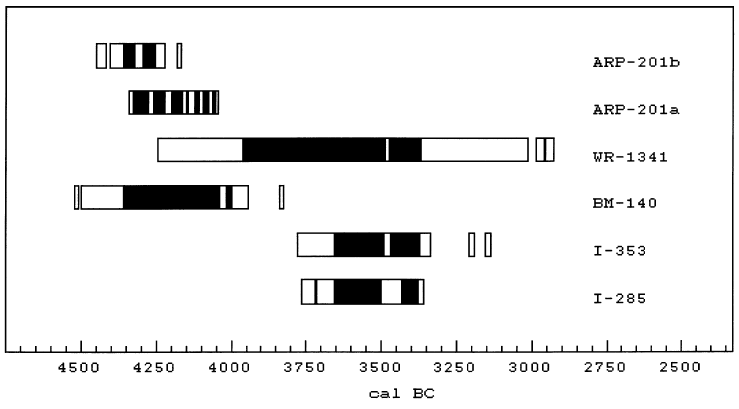 |
I had expected ARP-201a to simply confirm and refine the three grouped 1960s dates (i.e., I-285, I-353, and WR-1341). I was quite surprised when this was not the result.
Because the result was significantly different than expected the AMS lab volunteered to date the sample again, just to make sure that nothing had gone amiss during the AMS dating procedure. They had not needed to use the entire mat fragment for ARP-201a, and they suggested we might use what was left of the fragment to check the ARP-201a result. This sample is ARP-201b.[6] (ARP-201a and ARP-201b are thus duplicate measurements of a single sample.) Figure 2 shows that the two measurements are in good agreement. We may safely conclude that no blunder was made in dating ARP-201a.
In my original article I observed that three of the four radiocarbon dates from the 1960s on the mat and the treasure were in agreement. The fourth measurement, BM-140, which was older than the others by some 500 to 600 radiocarbon years, appeared to be in error. I argued that BM-140 should be excluded from further consideration in that article—it appeared to be an outlier.
It is now clear that BM-140 cannot be dismissed in this way. It is in good agreement with our modern results, ARP-201a and ARP-201b.
We thus have three radiocarbon dates for the Cave of the Treasure mat which group near 3550 B.C., and another three which group near 4250 B.C. Here is a mystery. Why should the Cave of the Treasure mat exhibit two discrete dates, separated from each other by seven hundred years?
Note, first of all, that this perplexity cannot be explained as due to isotope fractionation. One of the major objectives of this redating project was to measure the isotope fractionation effect in the reeds of the mat. This has now been accomplished. We now know that the fractionation effect adds about 255 years to the radiocarbon BP date in the case of the reeds (not the wood). If we assume that I-285 and WR-1341 were not corrected for isotope fractionation at the time of measurement (as seems likely) and correct them now, the date ranges shown in Figure 3 result. The discrepancy with WR-1341 is more or less eliminated, but this is more the result of its large imprecision—its calibrated 2σ date range spans more than a millennium—than its accuracy. Some discrepancy with I-285 yet appears likely. And the discrepancy with the wood sample, I-353, (whose isotope fractionation effect is still unknown, but which should be small relative to the reeds) remains as previously.
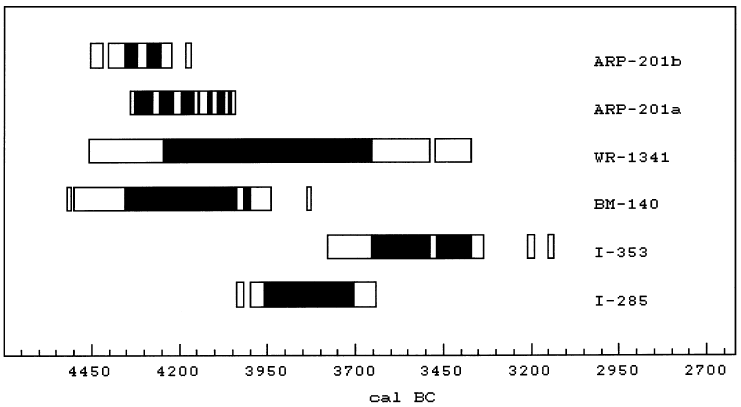 |
One possible solution is that both I-285 (on the mat) and I-353 (on the wood) are simply in error. These two dates were obtained by the same lab. If this lab's sample pretreatment method was inadequate back at that time, then the younger dates could be explained as due to inadequate removal of modern contamination. This is not impossible for that early time in the development of the technology of radiocarbon dating.
Another possibility is that the mat may be a composite of reeds from two different periods. This might have resulted if an older core had been repaired and added to using newer materials. This is not totally unthinkable, especially if the mat was part of the temple furnishings and had some ritual significance.
Pessah Bar-Adon, the archaeologist in charge of the excavation which discovered the mat and treasure, may have allowed this possibility. In regard to the disparate radiocarbon results obtained on the mat in the 1960s he noted:[7]
The two mat-fragments sent to the United States [I-285 and WR-1341] were taken from the outer edge, while the fragment sent to the British Museum [BM-140] was taken from the inner part of the mat.
To check the first theory—that both I-285 (on the mat) and I-353 (on the wood) are simply in error—one would really like to perform a modern radiocarbon analysis on the wood sample from which I-353 was taken. The wood cannot be a composite from two periods of time separated by hundreds of years. I have checked with the curator, Ms. Misch-Brandl, about this possibility and have learned that this sample of wood, unfortunately, no longer exists.
Visual examination of the mat apparently does not encourage the second possibility—that the mat is a composite from two time periods. Ms. Misch-Brandl has written, "It would be very strange to me if the different pieces of the mat have different dates".[8]
Ms. Misch-Brandl has supplied two additional samples from the mat itself to help address this question. These have been taken directly from the mat, to eliminate any question regarding sample provenience, from the locations shown in Figure 4.
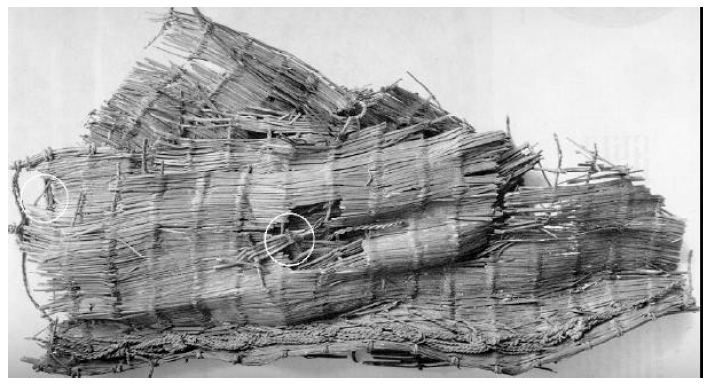 |
These two samples have also been submitted for radiocarbon dating. The first, ARP-212, is a short length of the twine used as weft in the construction of the mat. It is made of "straw"[9] rather than reed. The second sample, ARP-213, was entirely of reeds.
It seems most probable to me, from the evidence presently available, that the mat is all of one age with a proper (1σ) date of 4290±45 B.C. This is the date range one obtains from calibration of the three grouped dates BM-140, ARP-201a, and ARP-201b, as shown in Figure 5. I expect ARP-212 and ARP-213, and any other samples which might ever be dated from the mat in the future, to harmonize with this average date. If this is correct, then the mat dates to the middle of the Chalcolithic rather than late in the Chalcolithic. If this truly is the case it is of great interest to archaeology, but, unfortunately, it renders the mat of little further interest to Biblical chronology—the mat then dates many hundreds of years prior to the Biblical Flood date, as shown in Figure 5.
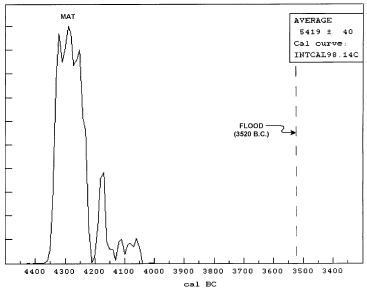 |
But will we be surprised again? Results from ARP-212 and ARP-213 should be available by the time the next issue of The Biblical Chronologist goes to press.
Meanwhile, it is clear that the mat can no longer be assumed to be a suitable proxy for radiocarbon dating the Flood. It may yet serve that purpose if ARP-212 or ARP-213 yields a suitably young radiocarbon date, thus corroborating the composite mat hypothesis. But we certainly cannot count on that outcome.
The loss of the mat as a check on the Biblical date of Noah's Flood—3520±21 B.C.—raises the issue of just how well checked that Biblical date currently is. Presently available secular data seem to exclude any date for the Flood which differs from 3520 B.C. by more than about 100 years at most, as the following discussion shows.
The termination of the Chalcolithic period in Palestine seems from much evidence to be unavoidably synchronous with the Flood. Thus the archaeological date of the end of the Chalcolithic is the first and most obvious check on the modern Biblical date of the Flood. This, in fact, is the date we had hoped to refine by radiocarbon dating the Cave of the Treasure mat.
The end of the Chalcolithic is variously dated by scholars. The New Encyclopedia of Archaeological Excavations in the Holy Land places it 3300 B.C.[10] The Archaeology of Ancient Israel suggests 3200–3000 B.C.,[11] but in that same volume Rivka Gonen notes:[12]
The calibration of radiocarbon dates effected since the early 1970s requires a revised approach to the chronology of the period. The dates now proposed push the Chalcolithic period back by several hundred years, roughly to the interval between the fifth millennium and about 3600 B.C.E.
These estimates yield a range from 3000 to 3600 B.C. for the end of the Chalcolithic, which probably adequately represents the range of scholarly opinion at present. In our usual (3σ) notation this is 3300±300 B.C., already in broad agreement with the Biblical date of 3520±21 B.C.
This archaeological check might be brought into closer agreement with 3520 B.C. by observing that the archaeological range of dates is presently biased toward the low (young) end by the archaeologists' assumption of continuity between the Chalcolithic and the next period, Early Bronze I. When one identifies the end of the Chalcolithic in Palestine with the Flood this assumption is seen to be invalid. It is probable that several centuries separated the resettling of Palestine in Early Bronze I from the extinction of Chalcolithic civilization brought about there by the Flood. Thus, while 3300–3000 B.C. might be a good archaeological estimate of the beginning of Early Bronze I period in Palestine, it cannot simply be assumed also to be a good estimate of the end of the Chalcolithic. Clearly, what is needed in this case, to get beyond the scholars' subjective biases, are definitive radiocarbon dates on samples from the end of the Chalcolithic—such as we had hoped the Cave of the Treasure mat might furnish.
The initial identification of the Flood in the secular earth science record was through the anomalous sediments at Elk Lake, Minnesota.[13] The anomaly is seen between sediment layers 5300 and 4700. On the basis of layer counting alone this would place the Flood at (1927 A.D. - 4700 years = ) about 2770 B.C. But radiocarbon dates on the sediments argue that between 14.8 and 18.9% of the annual sedimentary layers have been missed in the few sediment cores from Elk Lake which have so far been analyzed.[14] This correction places the secular date of the Flood from this evidence somewhere in the range 3470 – 3660 B.C. In our usual notation this is 3565±95 B.C., in good agreement with the Biblical date of 3520±21 B.C.
Another secular date employing layer counting as the basic chronological method, which we have previously discussed, comes from the ice cap on Devon Island, Canada.[15] The best estimate of the date of severe meltback of the ice cap (due to the Flood) we found based on measured annual layer thicknesses of ice was 3429 B.C. It is difficult to quantify the uncertainty in this date. Even 10% may not be too large. It seems appropriate to say, however, (if somewhat roughly), that the Devon Island evidence argues for a date of the Flood within about 500 years of 3400 B.C.
Two further secular checks on the Biblical date of the Flood come from Céide Fields, Ireland. Both rely on radiocarbon dating as their basic chronometer. The first results from radiocarbon measurements on ancient pine stumps found preserved in peat above pre-Flood archaeological remains.[16] The second is from radiocarbon measurements on peat from a deep bog at Céide Fields.[17]
Céide Fields is a vast agricultural landscape, including miles of stone walled fields, found buried today beneath a thick blanket of peat in North Mayo, Ireland. I have previously explained that this landscape is a pre-Flood landscape, preserved by an overgrowth of peat subsequent to the Flood.[18]
The initiation of peat growth over the agricultural fields is synchronous with the retreat of the Flood. Peat growth initiation at Céide Fields is placed between the extremes of 3765 and 3265 B.C. by Seamas Caulfield et al. based on a large number of radiocarbon dates from pine stumps preserved within the peat.[19] Written in our usual notation this is 3515±250 B.C., in good agreement with the Biblical date of 3520±21 B.C.
It is possible to reduce the uncertainty in the secular check somewhat by dating peat from Céide Fields directly. A number of peat cores have been extracted from a deep bog within the Céide Fields system. It is possible to locate the Flood in this peat core via palynology (i.e., pollen analysis). The Flood corresponds to a sudden pronounced change from increasing field types of pollen to increasing forest types of pollen.[20] This change in pollen types results from the removal of Céide Fields' pre-Flood agricultural inhabitants by the Flood and the overgrowth of their agricultural fields by peat bog and pine forest following the Flood.
The chronology in this instance has been constructed entirely independently of all Biblical chronological considerations by palynologists Karen Malloy and Michael O'Connell. Their chronology of the peat cores, based on radiocarbon, yields a date for the sudden pollen change of 3516±150 years.
These five secular checks on the date of the Flood are shown in Figure 6. Collectively they yield a weighted average for the secular date of the Flood of 3530±73 B.C. This is in excellent agreement with the date from modern Biblical chronology of 3520±21 B.C. Since this check is based on a variety of records exploited by a variety of researchers working with a variety of chronometric methods it seems reasonably robust, even though the individual checks are few in number. The radiocarbon dates involved in this check have all been obtained in the past few years, rather than three and a half decades ago, so they seem reasonably secure. All things considered, no reason appears from the secular data to mistrust the Biblical chronology computation leading to 3520±21 B.C. as the proper date of Noah's Flood.
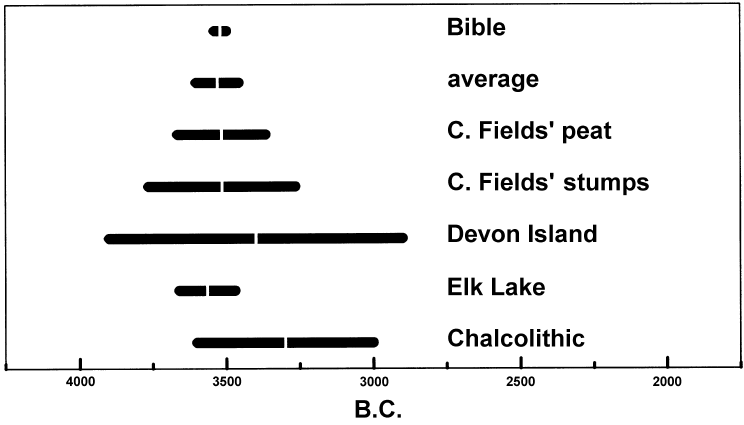 |
While the waters of the Flood covered only the northern hemisphere, according to the hemispherical Flood model, the Flood event still necessarily impacted the entire globe.[21] Evidence of the Flood is expected to be apparent in one form or another in nearly every secular chronology covering the appropriate time range, both in the northern hemisphere and in the southern hemisphere. This makes the Flood of enormous importance, not only to Biblical chronology, but to all secular chronologies of earth history as well. The Flood presents a distinct, global, dating "horizon" through which all chronologies of the past from all fields may be synchronized. As a result the Flood seems destined to become the most intensely studied and precisely dated event of ancient history in the decades which lie immediately before us.
Because of its great importance to chronology, and chronology's great importance to a proper view of history, and the great importance of a proper view of history to a proper conception of God, the date of the Flood warrants special attention within the discipline of Biblical chronology. Every effort should be made to check and refine this date using secular chronometric tools and methods.
The apparent loss of the check which might have been afforded by the Cave of the Treasure mat is unfortunate, especially in view of the time, money, and energy which have been invested in it. Figure 6 shows that of the five checks presently available, the archaeological assessment of the end of the Chalcolithic is the furthest from the mean and the second most imprecise. It is this check which we had hoped to refine by redating the mat. Improvement of this one data point promised to significantly strengthen the overall secular check on the Biblical date of the Flood.
While the mat seems no longer a suitable sample for radiocarbon dating the end of the Chalcolithic, it seems probable that numerous other suitable archaeological samples will eventually be found to fill this need.
Meanwhile, other candidates which might serve as proxies for radiocarbon dating the Flood exist or can be imagined, and these should be pursued. An obvious candidate, for example, is a sample of the charcoal from above the mineral soil, among the fallen stones of the collapsed walls at Céide Fields.[22] Another particularly intriguing potential candidate—or perhaps I should say, the mother lode of candidates—is the ark of Noah itself, should remains of it eventually be found.[23] Wood from the ark would date somewhat prior to the Flood, of course, depending upon how long before the Flood the trees grew from which the wood was taken. Any cereal grains found aboard the ark would be expected to date indistinguishably close to the Flood, as would any dung from animals aboard the ark—of which there might be quite a supply.
The search for the ark on Mt. Cilo continues to be actively pursued by The Biblical Chronologist even as I write. The possibility that this long-sought ancient vessel might soon be brought to light remains. And should that happen, it seems likely that Biblical chronology—and much else besides—would benefit greatly. ◇
Biblical chronology is not an infallible endeavor. Indeed, the history of the discipline of Biblical chronology shows that it is, if anything, rather error prone.
I think this fact may be difficult for the lay person to understand. Isn't The Biblical Chronologist a conservative Christian publication, and is it not the case that conservative Christians hold to the inerrancy of the Bible?
Yes, The Biblical Chronologist is a conservative Christian publication, and yes it is the case that conservative Christians hold to the inerrancy of the Bible. But the fact that the Bible is without error does not mean that the discipline of Biblical chronology is without error.
The problem is that the discipline of Biblical chronology is a human endeavor, not a divinely revealed one. Notice, for example, that the Bible does not supply us with the date of Creation. The Bible does supply us with chronological data pertinent to the question of the date of Creation, such as the genealogical lists in Genesis 5 and Genesis 11. Apart from these data it would be all but hopeless to attempt to date Creation. But to use this data to accurately date Creation, one must first overcome a number of hermeneutical hurdles.
For example, it is a simple fact that the critical numbers in Genesis 5 and 11 for calculating the date of Creation show a great deal of variation in the oldest extant texts of Genesis. This plunges one immediately and unavoidably into difficult issues regarding the preservation of Scripture. Which set of numbers, from which ancient texts, is more likely to be true to the original, inerrant autographs?
In addition one necessarily encounters interpretive issues. For example, should the genealogies of Genesis 5 and 11 be interpreted as direct father-son lines, or might "begot" signify grandfather-grandson in some instances?
This is only a sampling of problems which confront the Biblical chronologist. They are sufficient, however, to illustrate that while the Bible is—according to conservative doctrine—inerrant in the original autographs, the discipline of Biblical chronology is a decidedly human endeavor, and as such it is not and cannot be without error.
I enjoy looking through old books on Biblical chronology. One by Rev. William Hales, D.D., published back in 1830, has a table listing dates of Creation computed by various Christian and non-Christian scholars known to the author back at that time (Figures 7 and 8). The table fills three pages. Following the table Hales summarizes thus:[24]
Here are upwards of 120 different opinions, and the list might be swelled to 300; as we are told by Kennedy, in his Chronology, p. 350. This specimen, however, is abundantly sufficient to shew the disgraceful discordance of chronologers, even in this prime era: the extremes differing from each other, not by years, nor by centuries, but even by chiliads [millenia]; the first exceeding the last no less than 3268 years!
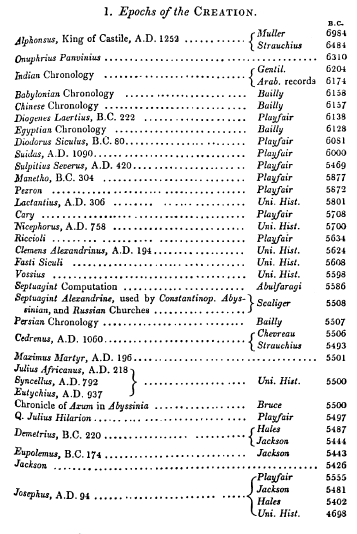 |
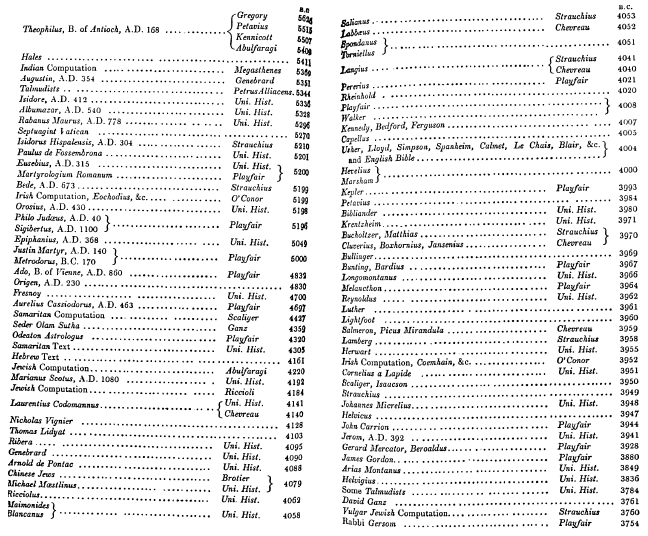 |
The "disgraceful discordance of chronologers" which Hales noted is amply demonstrated by his table not only between secular chronologists and Biblical chronologists, but also between one Biblical chronologist and the next. But this discordance is hardly "disgraceful" in my opinion. It is a mere reflection of the fact that the discipline of chronology, including that branch known as Biblical chronology, is a human endeavor, and humans are, however unfortunately—even when they use the infallible Word of God as their starting point—fallible.
I have tried to keep the fact that Biblical chronology is a human endeavor before our eyes within the pages of The Biblical Chronologist. That is why, for example, I routinely give Biblical chronology dates with an uncertainty attached—the date of the Flood, for example, as 3520±21 B.C. I want to communicate in every case that the date has been derived from certain Biblical data—it is not itself part of the Bible—and this process of derivation necessarily entails uncertainties. The range of uncertainty (±21 years in the preceding example) expresses the extent of known uncertainties only. In addition to these there may be other, unknown, errors. These cannot be quantified for the very reason that they are unknown.
Because the discipline of Biblical chronology is a human endeavor, and because humans are fallible, proper humility demands that the Biblical chronologist check the Biblical dates he or she has derived from Scripture in whatever ways he or she can manage. The temptation to canonize one's Biblical chronology dates, on the grounds that they have been obtained from inerrant Scripture, is, in the final analysis, a temptation to blasphemy. It overlooks the fact that the chronologist is a fallible human, not God.
Secular historical and scientific chronologies of the past provide the primary means of checking the Biblical chronologist's work. This is another area where I feel it is easy for conservative Christians to become confused. Isn't it impious to check Biblical chronology using secular historical and scientific chronologies? Isn't this giving precedence to the secular over the sacred—isn't this putting science above the Bible?
No, this is not putting science above the Bible. Nobody is claiming infallibility for the secular chronologies. All admit that they, too, are worked out by fallible humans and are error prone. Rather than putting science above the Bible, this is simply, humbly, putting ourselves beneath both the Bible and science. It is admitting our own fallibility as Biblical chronologists and doing what we can to expose and correct our errors.
When we find discord between our Biblical chronology dates and the secular dates of the same events, we do not judge the Bible wrong and science correct. The problem, we believe, has nothing to do with the infallibility of the Bible versus the fallibility of science—it has only to do with our fallibility. We judge only that some human or humans have made one or more mistakes somewhere; either the Biblical chronologist in his derivation or the secular chronologist in his—or both. This is the normal conservative Christian position in all areas where Biblical and extra-Biblical knowledge intersect.
[S]ince God, the author of all Scripture, is also the Lord of all facts, there can in principle be no contradiction between a right understanding of what Scripture says and a right account of any reality or event in the created order. Any appearance of contradiction here would argue misunderstanding or inadequate knowledge, either of what Scripture really affirms or of what the extra-biblical facts are. Thus it would be a summons to reassessment and further scholarly inquiry.[25]
Biblical chronology, like all human disciplines, is fallible. Like all human endeavors our results from Biblical chronology need to be checked in every way possible—including, most especially, against extra-Biblical chronological data. This has, in fact, been the practice of Christian chronologists at least as far back as Eusebius. Indeed, our job as Biblical chronologists is to bring all available Biblical and extra-Biblical data bearing on a particular chronological problem into reasonable harmony. Then, and only then, do we have objective reason to believe that we have got our Biblical chronology basically correct.
The truly wonderful advantage we possess today over former Biblical chronology scholars is the many secular chronometric tools, especially tree-ring calibrated radiocarbon, made available only in recent decades by modern science—tools which former generations of Biblical scholars would likely have given their right arms to have access to. Using these new tools we are able to weed out errors within our discipline of Biblical chronology as never before. Let us apply these new tools intelligently and correctly at every opportunity, to the glory of God. ◇
The Biblical Chronologist is a bimonthly subscription newsletter about Biblical chronology. It is written and edited by Gerald E. Aardsma, a Ph.D. scientist (nuclear physics) with special background in radioisotopic dating methods such as radiocarbon. The Biblical Chronologist has a threefold purpose: to encourage, enrich, and strengthen the faith of conservative Christians through instruction in Biblical chronology, to foster informed, up-to-date, scholarly research in this vital field within the conservative Christian community, and to communicate current developments and discoveries in Biblical chronology in an easily understood manner. An introductory packet containing three sample issues and a subscription order form is available for $9.95 US regardless of destination address. Send check or money order in US funds and request the "Intro Pack." The Biblical Chronologist (ISSN 1081-762X) is published six times a year by Aardsma Research & Publishing, 412 N Mulberry, Loda, IL 60948-9651. Copyright © 2000 by Aardsma Research & Publishing. Photocopying or reproduction strictly prohibited without written permission from the publisher.
|
^ Gerald E. Aardsma, "Radiocarbon Dating Noah's Flood," The Biblical Chronologist 3.6 (November/December 1997): 1–11.
^ Pessah Bar-Adon, The Cave of the Treasure (Jerusalem: The Israel Exploration Society, 1980), 7.
^ Gerald E. Aardsma, "Radiocarbon Dating Noah's Flood," The Biblical Chronologist 3.6 (November/December 1997): 7.
^ Numbers reported by the NSF-Arizona AMS Laboratory for ARP-201a (lab AA#: AA35141) include δ13C = -9.40, F = 0.5121±0.0035, and 14C age BP = 5375±55.
^ Calibration of these radiocarbon dates was carried out using the 1998 atmospheric decadal dataset of CALIB rev. 4.0. See M. Stuiver and P. J. Reimer, "Extended 14C Data Base and Revised CALIB 3.0 14C Age Calibration Program," Radiocarbon 35.1 (1993): 215–230.
^ Numbers reported by the NSF-Arizona AMS Laboratory for ARP-201b (lab AA#: AA35141) include δ13C = -8.9 and 14C age BP = 5475±60.
^ Pessah Bar-Adon, The Cave of the Treasure (Jerusalem: The Israel Exploration Society, 1980), 216.
^ Personal communication 00/03/07.
^ Pessah Bar-Adon, The Cave of the Treasure (Jerusalem: The Israel Exploration Society, 1980), 192.
^ Chronological Tables, The New Encyclopaedia of Archaeological Excavations in the Holy Land, vol. 4 (New York: Simon & Schuster, 1993), 1529.
^ Amnon Ben-Tor, "Introduction," The Archaeology of Ancient Israel, ed. Amnon Ben-Tor (New Haven: Yale University Press, 1992), 2.
^ Rivka Gonen, "The Chalcolithic Period," The Archaeology of Ancient Israel, ed. Amnon Ben-Tor (New Haven: Yale University Press, 1992), 42.
^ Gerald E. Aardsma, "Noah's Flood at Elk Lake," The Biblical Chronologist 2.6 (November/December 1996): 1–13.
^ Gerald E. Aardsma, "Noah's Flood at Elk Lake–Technical Appendix," The Biblical Chronologist 2.6 (November/December 1996): 10–13.
^ Gerald E. Aardsma, "Noah's Flood at Devon Island," The Biblical Chronologist 3.4 (July/August 1997): 1–16.
^ Gerald E. Aardsma, "Noah's Flood: The Irish Evidence," The Biblical Chronologist 5.3 (May/June 1999): 1–7.
^ Gerald E. Aardsma, "The Pre-Flood Settlement of Ireland," The Biblical Chronologist 5.4 (July/August 1999): 1–7.
^ Gerald E. Aardsma, "Noah's Flood: The Irish Evidence," The Biblical Chronologist 5.3 (May/June 1999): 1–7.
^ Seamas Caulfield, R. G. O'Donnell, and P. I. Mitchell, "14C Dating of a Neolithic Field System at Céide Fields, County Mayo, Ireland," Radiocarbon 40.2 (1998): 629–640.
^ Gerald E. Aardsma, "The Pre-Flood Settlement of Ireland," The Biblical Chronologist 5.4 (July/August 1999): 1–7.
^ Gerald E. Aardsma, "The Cause of Noah's Flood," The Biblical Chronologist 3.5 (September/October 1997): 1–14.
^ Gerald E. Aardsma, "The Opening Minutes of Noah's Flood at Céide Fields, Ireland," The Biblical Chronologist 5.6 (November/December 1999): 1–10.
^ Gerald E. Aardsma, "The Ark on Ararat?," The Biblical Chronologist 3.2 (March/April 1997): 1–12; Gerald E. Aardsma, "Research in Progress," The Biblical Chronologist 5.3 (May/June 1999): 7–16.
^ Rev. William Hales, D.D., A New Analysis of Chronology and Geography, History and Prophecy 2nd ed. (London: C.J.G. & F. Rivington, 1830), 214.
^ Norman L. Geisler, Explaining Hermeneutics: A Commentary ICBI Foundation Series 6 (Oakland, CA: International Council on Biblical Inerrancy, 1983), 32.